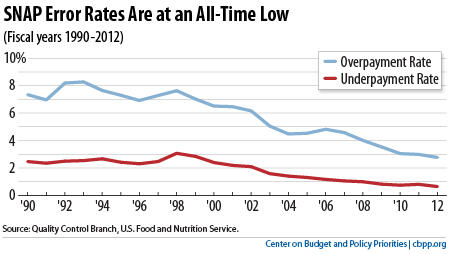BEYOND THE NUMBERS
Setting the Record Straight on SNAP, Part 3: Waving the "Fraud, Waste, and Abuse" Flag
Some House Republican leaders have sought to portray SNAP as rife with fraud and abuse to help justify their proposals to cut millions of people from the program and slash $40 billion from SNAP. The facts are not on their side. A history of bipartisan congressional oversight and strong attention to SNAP program integrity from the Agriculture Department (USDA) and states have made SNAP one of the most efficient and effective programs we have.
The SNAP overpayment rate — that is, the share of benefits either issued to ineligible households or overpaid to eligible households — was just 2.77 percent last year (see graph). The large majority of overpayments reflect inadvertent mistakes by recipients, eligibility workers, data entry clerks, or computer programmers, not fraud.

In addition, when you subtract SNAP underpayments — benefits that should have gone to eligible participating households but didn’t because of errors — the net loss to the government last year was about 2 percent of benefits. By contrast, the IRS estimates that about 15 percent of income taxes go unpaid.
It’s also important to understand that fighting SNAP fraud isn’t a partisan issue. Under Congressional oversight, the USDA, in both Republican and Democratic administrations, has worked to root out fraud in SNAP. As a result, SNAP fraud is low. Nonetheless, USDA and Congress are working together to continue that progress and address new issues as they arise.
USDA has intensified these efforts in recent years. It has expanded its fraud investigations: in fiscal year 2012, for example, USDA reviewed over 15,000 retail stores to ensure that they aren’t illegally converting SNAP benefits into cash (known as “trafficking”) and conducted nearly 4,400 undercover investigations. USDA has also proposed new rules to combat fraud, increased penalties on stores for committing fraud, and given states new resources to prevent fraud.
States fight fraud as well, completing several hundred thousand fraud investigations and disqualifying 46,000 people in fiscal year 2011.
Additional common-sense measures are in the works. The Senate and the House Agriculture Committee have passed separate bills that would end SNAP benefits for lottery winners and give states new tools to identify recipients who sell their benefits for cash. Both bills also include more resources to help detect retailer fraud, such as “data mining” technology to help identify stores that could be trafficking SNAP benefits.
While SNAP fraud is very low, any amount of fraud is unacceptable, and policymakers should continue to do all they can to fight it. But they should not use highly inflated rhetoric about SNAP fraud and abuse as a cover for deep benefit cuts that would take food away from honest, needy American families, children, and seniors.
Next up: SNAP enrollment is still high because the job market is still bad.
